Step into the world of rock and roll royalty as we unravel the mysteries behind the blistering sound of one of its greatest icons. Known for his thunderous riffs and commanding stage presence, James Hetfield has left an indelible mark on the music industry. But what is the secret weapon behind Hetfield’s legendary sound? This definitive guide will delve into the depths of his guitar gear, revealing the instrument that has become the backbone of his sonic empire. Prepare to unlock the secrets of Hetfield’s musical arsenal and discover the guitar that effortlessly shapes his unique sound.
Who is James Hetfield?
James Hetfield is an American musician, singer, and songwriter best known as the co-founder, lead vocalist, rhythm guitarist, and main songwriter for the heavy metal band Metallica. He was born on August 3rd, 1963 in Downey, California.
Hetfield’s musical journey began at a young age when he started taking piano lessons. However, his love for heavy metal music came later when he was introduced to bands like Led Zeppelin and Black Sabbath. He started playing guitar at the age of 14 and formed his first band, Obsession, in high school.
Over the years, Hetfield’s songwriting skills have earned him critical acclaim, with many of Metallica’s songs becoming anthems for their fans. He has also collaborated with other notable musicians such as Ozzy Osbourne and Alice in Chains.
Apart from his musical pursuits, Hetfield has also been involved in various philanthropic efforts. He and Metallica have donated millions of dollars to charities supporting causes like disaster relief, veterans’ organizations, and environmental conservation.
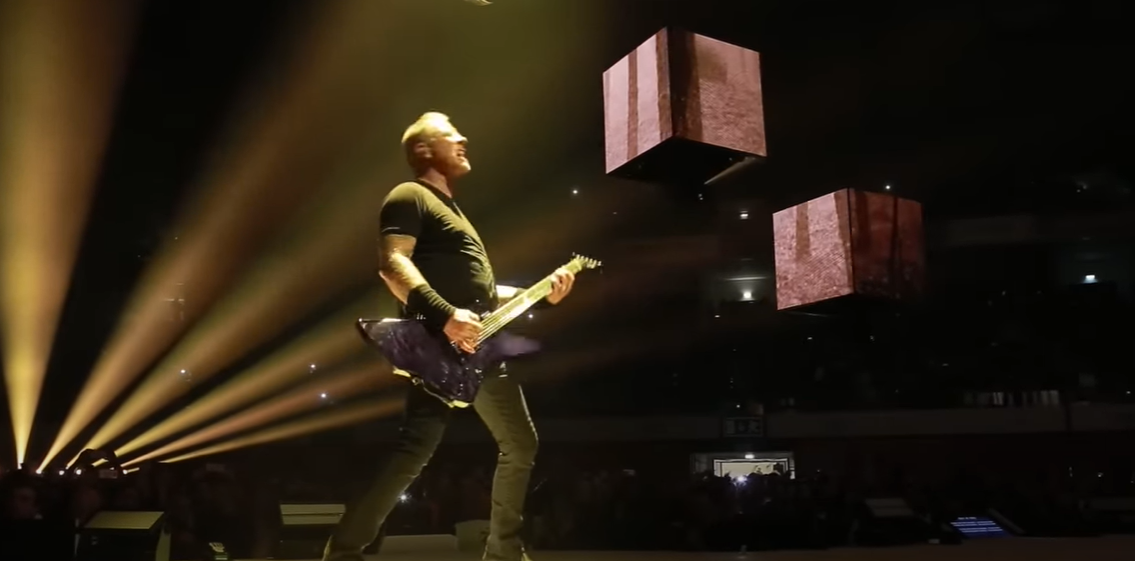
In recent years, Hetfield has opened up about his struggles with addiction and mental health issues. Through the support of his family and bandmates, he has overcome these challenges and continues to be an inspiration for many.
As Metallica celebrates its 40th anniversary in 2021, Hetfield’s influence on the band’s sound and legacy cannot be overstated. He remains a respected and beloved figure in the music industry, with his passion for creating powerful and meaningful music still burning strong after all these years [1].
What Guitars Does James Hetfield Play?
Ken Lawrence Explorer, aka “Carl”
James Hetfield is known not only for his distinctive and powerful vocals in Metallica but also for his iconic guitar playing. Throughout the years, he has played a variety of guitars on stage and in the studio, each with its own unique sound and style. One particular guitar that stands out in his collection is the Ken Lawrence Explorer, known as “Carl”.
The Ken Lawrence Explorer was custom-made for Hetfield in 1991 by luthier Ken Lawrence. It features a unique body shape, based on the classic Gibson Explorer model, with a carved top and flame maple veneer. The guitar also has a mahogany neck and an ebony fretboard, providing a warm tone and smooth playability.
What sets this guitar apart is the intricate artwork and details that James Hetfield personally designed. The body of the guitar is adorned with intricate Celtic knotwork and a dragon inlays, all inspired by Hetfield’s love for Norse mythology. In addition, the headstock has a custom “JH” logo inlaid with mother-of-pearl.
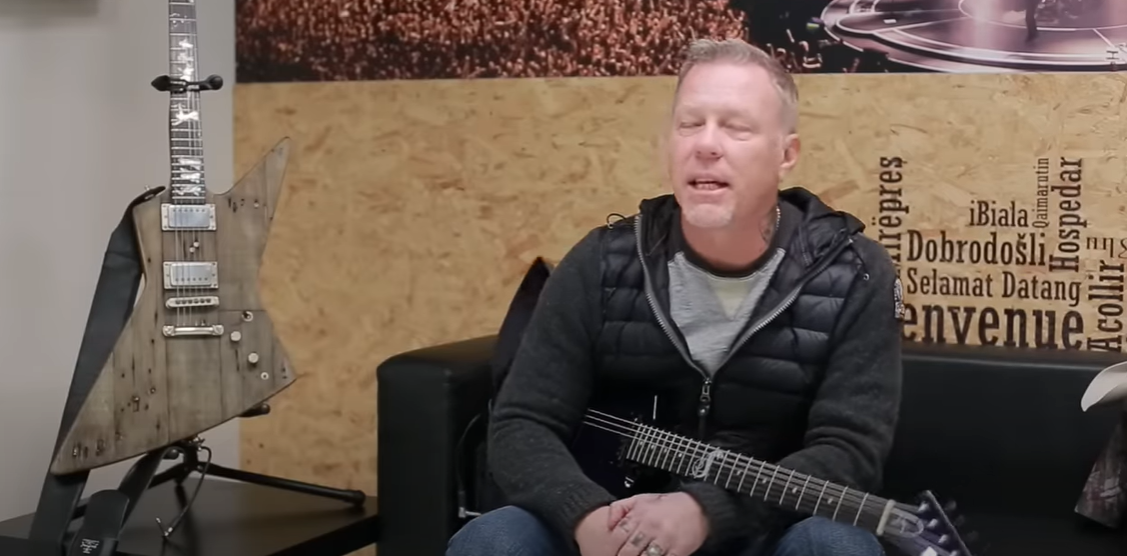
1996 Custom Ken Lawrence Explorer
Another notable guitar in Hetfield’s extensive collection is the 1996 Custom Ken Lawrence Explorer. This guitar, like “Carl,” was meticulously crafted by Ken Lawrence, showcasing his exceptional skill and attention to detail. With a carved top, flame maple veneer, and a finely crafted mahogany neck featuring an exquisite ebony fretboard, this instrument is a true work of art.
What sets this particular guitar apart is its striking black finish and luxurious gold hardware. These elements not only contribute to its sleek and elegant appearance but also reflect Hetfield’s refined taste and style.
But it’s not just the aesthetics that make this guitar special. When it comes to sound, Hetfield himself has mentioned that the 1996 Custom Ken Lawrence Explorer produces a punchier and brighter tone compared to his other guitars. This is attributed to the unique combination of a maple top and an ebony fretboard, which enhances sustain and clarity in the high frequencies. The result is a vibrant sound that captivates both the player and the audience.
With its exceptional craftsmanship, distinct design, and remarkable tonal qualities, the 1996 Custom Ken Lawrence Explorer stands as a testament to the artistry and innovation that define Hetfield’s guitar collection.
Ken Lawrence Custom Flying V
The Ken Lawrence Custom Flying V is another exceptional guitar in James Hetfield’s collection. This guitar was also custom-made by Ken Lawrence and features a body made from African mahogany with a stunning flame maple top.
But what sets this guitar apart is its unique design and features, such as the one-of-a-kind control panel on the lower body, which allows for quick and easy adjustments during live performances. The guitar also has a custom bridge and tuners, as well as Hetfield’s signature EMG pickups, all contributing to its distinctive sound.
In addition to its impressive features and design, the Ken Lawrence Custom Flying V has a special significance to Hetfield. This guitar was used heavily during the recording of Metallica’s “St. Anger” album, making it an important part of the band’s history and sound.
From the intricate artwork to the exceptional tonal qualities, each guitar in James Hetfield’s collection holds a special place in his heart and has played a significant role in shaping his unique style and sound as a musician. Although he may play different guitars at different times, one thing remains consistent – Hetfield’s passion and dedication to his craft, evident in every note he plays.
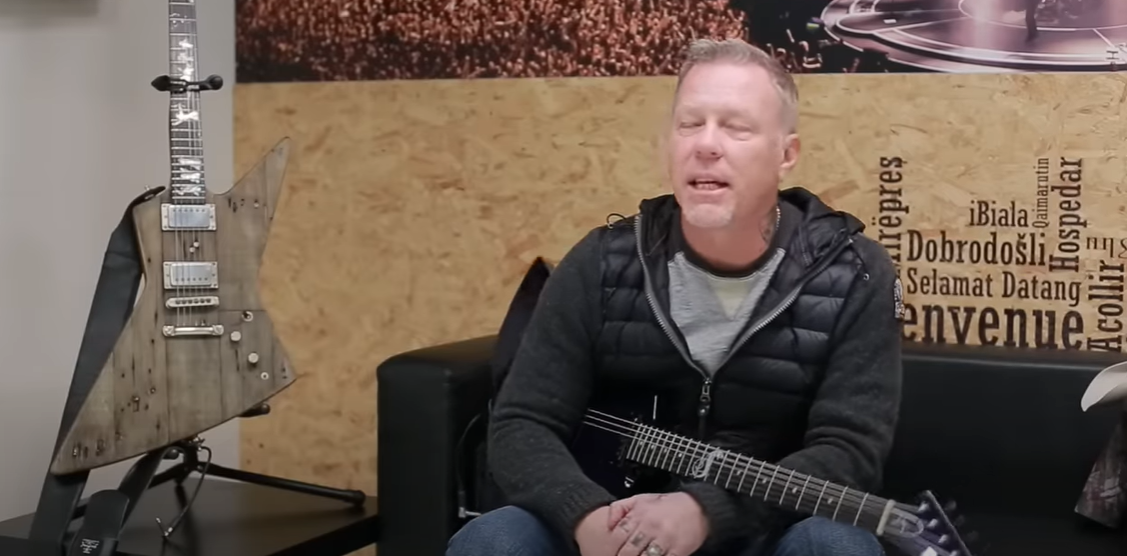
1973 Gibson Les Paul Custom “Iron Cross”
Finally, no discussion of James Hetfield’s guitars would be complete without mentioning the iconic 1973 Gibson Les Paul Custom “Iron Cross” – one of his most recognizable and beloved instruments. This guitar was originally owned by fellow musician Wayne Kramer and later acquired by Hetfield in a trade.
But it’s not just the appearance that makes this guitar special. It has been heavily used by Hetfield throughout his career, making appearances on several Metallica albums and tours. Its distinctive sound and playability make it a staple in Hetfield’s live performances, earning its place as an iconic instrument in his collection.
ESP James Hetfield Iron Cross
In 2009, ESP released the James Hetfield Iron Cross guitar, an updated version of his iconic Gibson Les Paul Custom. This guitar features a mahogany body and neck with a custom iron cross graphic finish and white binding, giving it a striking and unique appearance.
But it’s not just about the looks – this guitar also has a set of active EMG pickups, providing a powerful and dynamic tone that can be heard on many of Metallica’s recent albums. The guitar also has a thin U-shaped neck profile, making it comfortable and easy to play for long periods.
As with all of James Hetfield’s guitars, the Iron Cross model is more than just an instrument – it holds personal significance and plays a crucial role in his music. Its powerful sound and unique design make it a must-have for any serious guitar enthusiast.
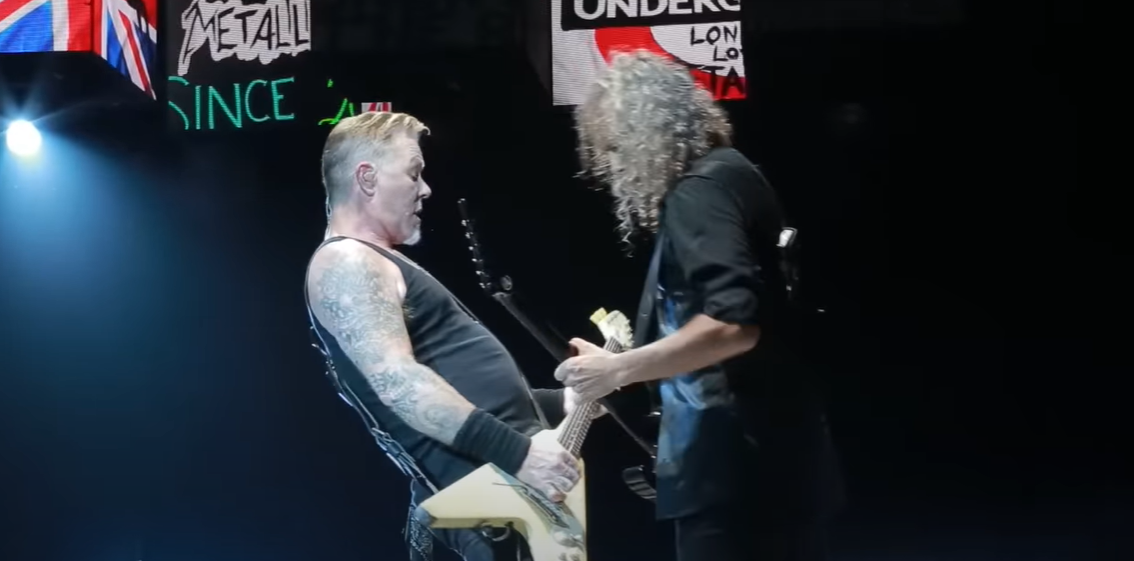
ESP James Hetfield Snakebyte
Another notable ESP model in Hetfield’s collection is the Snakebyte, a guitar designed with input from the Metallica frontman himself. This guitar features a mahogany body and neck, along with an ebony fretboard and EMG pickups.
What sets the Snakebyte apart is its unique design, inspired by both traditional and modern guitar styles. It has a thick single-cutaway body, reminiscent of classic guitars, but also has a more angular shape and sharp edges, giving it a modern and aggressive look.
In addition to its striking appearance, the Snakebyte also boasts exceptional playability and sound. Its fast neck and powerful pickups make it perfect for heavy riffs and solos, making it a go-to guitar for Hetfield on stage.
ESP James Hetfield Snakebyte Custom Baritone
For those looking for a more unique and specialized guitar, the ESP James Hetfield Snakebyte Custom Baritone is an excellent choice. This guitar is essentially a modified version of the standard Snakebyte model, with a longer scale length and thicker strings.
The result is a lower and darker tone, perfect for playing heavy and aggressive riffs. It also has a sleek black finish with a custom snake inlay on the body, giving it a bold and menacing appearance.
The Snakebyte Custom Baritone is not for the faint of heart – it’s a powerful and intense instrument that truly reflects James Hetfield’s style and sound. For those looking to replicate his heavy tone and play like The Metal God himself, this guitar is definitely worth considering.
ESP MX220, aka “Eet Fuk”
One of the most unique and controversial guitars in James Hetfield’s collection is the ESP MX220, also known as “Eet Fuk.” This guitar features a distinctive black and white polka dot finish, along with custom graphics and a skull-shaped headstock.
But it’s not just about the looks – this guitar has some impressive sound qualities as well. It features EMG pickups and a Floyd Rose tremolo system, allowing for versatile playing styles and techniques. The guitar also has a 24-fret ebony fretboard with custom inlays, making it a favorite among many Metallica fans.
Although its appearance may be polarizing, there’s no denying the impact that Eet Fuk has had on James Hetfield’s sound. Its bold design and powerful sound make it a standout among his collection and a testament to Hetfield’s fearless attitude as a musician.
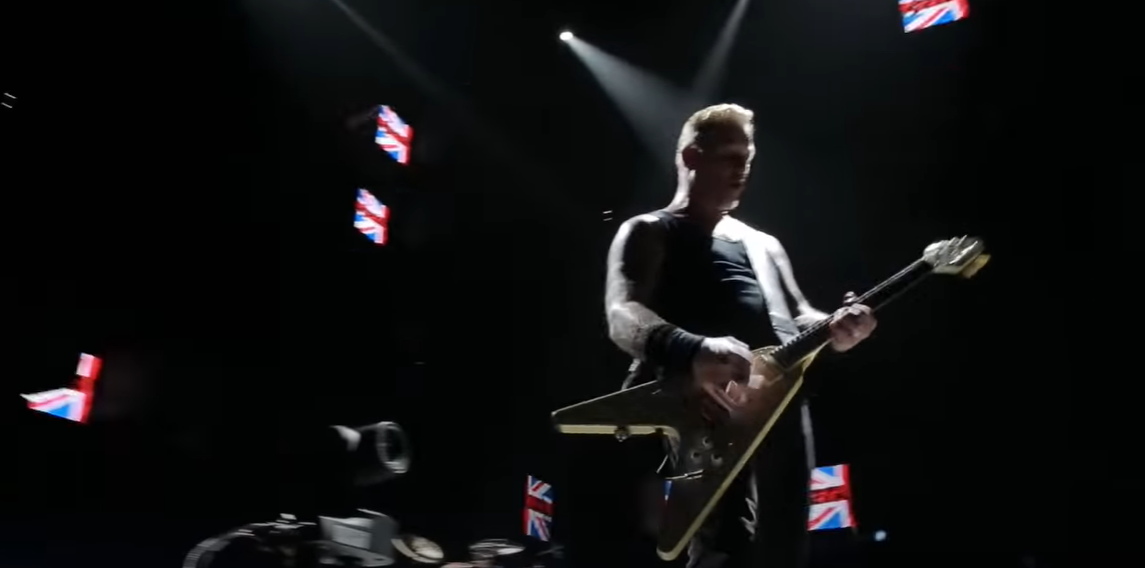
1984 Gibson Explorer, aka “So What”
The 1984 Gibson Explorer, also known as “So What” features a striking black and white graphic finish with custom inlays and a skull-shaped headstock – a common theme among Hetfield’s guitars. But what sets this guitar apart is its unique history. It was originally owned by Metallica’s late bassist, Cliff Burton, and was given to Hetfield as a gift after Burton passed away.
This guitar has been heavily used by Hetfield throughout his career, making appearances on several Metallica albums and tours. Its powerful sound and unique design make it a staple in Hetfield’s live performances, serving as both a tribute to Burton and an iconic instrument in its own right.
1985 Jackson King V Custom, aka “Kill Bon Jovi”
The 1985 Jackson King V Custom, also known as “Kill Bon Jovi,” is a significant guitar in James Hetfield’s collection for several reasons. Firstly, it was custom-made for him by the legendary luthier Grover Jackson. Secondly, it features a unique white and black graphic finish with custom artwork and skull inlays.
But what truly makes this guitar stand out is its role in Metallica’s infamous “Metal Up Your Ass” photo shoot. The band posed with the guitar, which had Bon Jovi scrawled across it, sparking a feud between the two bands and earning this instrument its nickname.
Despite its controversial history, there’s no denying that the Jackson King V Custom is an iconic and essential piece of James Hetfield’s collection. Its powerful sound and bold design make it a standout among his guitars and a testament to Metallica’s fearless attitude towards music.
1988 ESP MX220, aka “Fuk Em Up”
The 1988 ESP MX220, also known as “Fuk Em Up,” is another guitar in James Hetfield’s collection with a controversial and provocative design. This guitar features a white and red graphic finish with aggressive artwork and skull inlays.
But it’s not just about the looks – this guitar packs a punch when it comes to sound. It has EMG pickups and a Floyd Rose tremolo system, allowing for versatile playing styles and techniques. It also has a 24-fret ebony fretboard with custom inlays, making it both visually stunning and exceptional to play.
The Fuk Em Up guitar is a perfect representation of James Hetfield’s aggressive style and fearless attitude towards music. Its bold design and powerful sound make it a standout among his collection and a must-have for any Metallica fan [2].
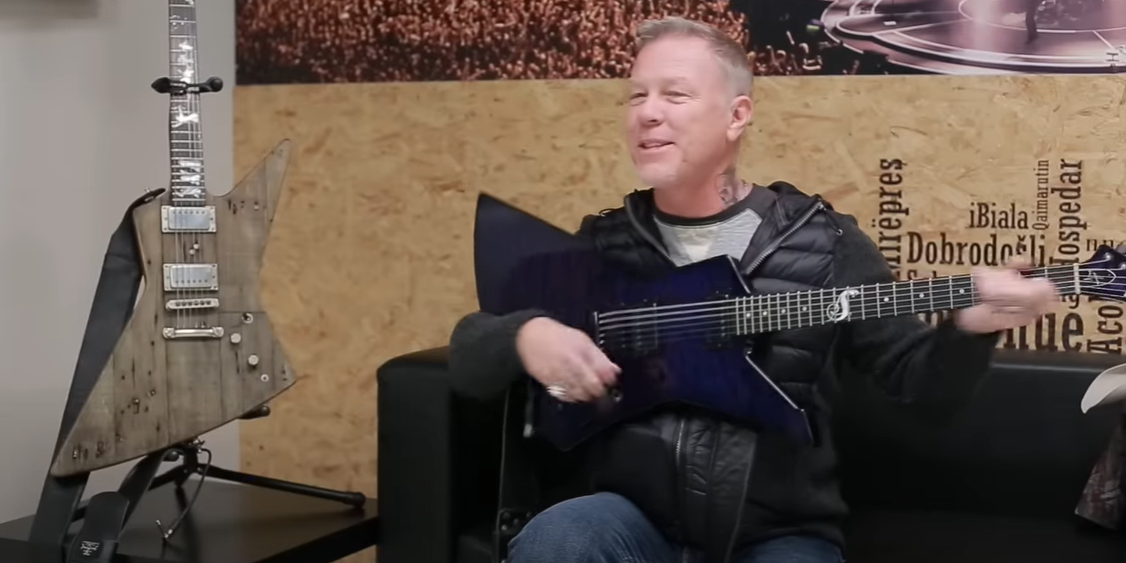
List of Amps and Other James Hetfield Gear
Marshall JMP, Most Likely the JMP 2203 Model
Although James Hetfield is often associated with Mesa/Boogie amplifiers, he has also used Marshall amps throughout his career. One of the most commonly used models is the Marshall JMP, specifically the 2203 model.
The Marshall JMP was first introduced in the late 1960s and quickly gained popularity among rock and metal guitarists. It features a single channel, two inputs, and a three-band EQ, making it a simple yet powerful amp for aggressive tones.
While the exact year of Hetfield’s JMP purchase is not known, he has been seen using it as early as 1983 during Metallica’s “Kill ‘Em All” tour. He used this amp extensively throughout the 80s and 90s, including on albums such as “Master of Puppets” and “The Black Album.”
Marshall JCM800 2203KK “Kerry King” Signature Amp
In addition to the standard JMP, Hetfield has also used the Marshall JCM800 2203KK “Kerry King” signature amp. This collaboration between Kerry King of Slayer and Marshall was released in 2007 and features a modified version of the famous 2203 model.
This amp is known for its aggressive tone and high gain capabilities, making it a perfect fit for Hetfield’s playing style. He used this amp on Metallica’s album “Death Magnetic” and continues to use it live.
Mesa/Boogie Mark IIC+ and Rectifier
While the Marshall amps may be more closely associated with Hetfield, he has also been known to use Mesa/Boogie amps. In the 90s, he used a Mesa/Boogie Mark IIC+ for albums such as “Load” and “Reload.” The Mesa/Boogie Mark IIC+ is renowned for its versatile tonal capabilities, allowing Hetfield to achieve a wide range of sounds and textures. Its rich, expressive clean tones and searing high-gain distortion have made it a favorite among guitarists in various genres.
Furthermore, in the early 2000s, Hetfield incorporated a Mesa/Boogie Rectifier amp into Metallica’s sonic arsenal, specifically on the album “St. Anger.” The Rectifier is known for its distinctive heavy tone, characterized by tight low-end response and crushing overdriven saturation. This iconic amp has become a staple in modern metal music, influencing countless guitarists and shaping the sound of the genre.
By utilizing these different Mesa/Boogie amps alongside his Marshall setups, Hetfield has been able to push the boundaries of his sonic palette and deliver the powerful, dynamic guitar tones that have become synonymous with Metallica’s signature sound.
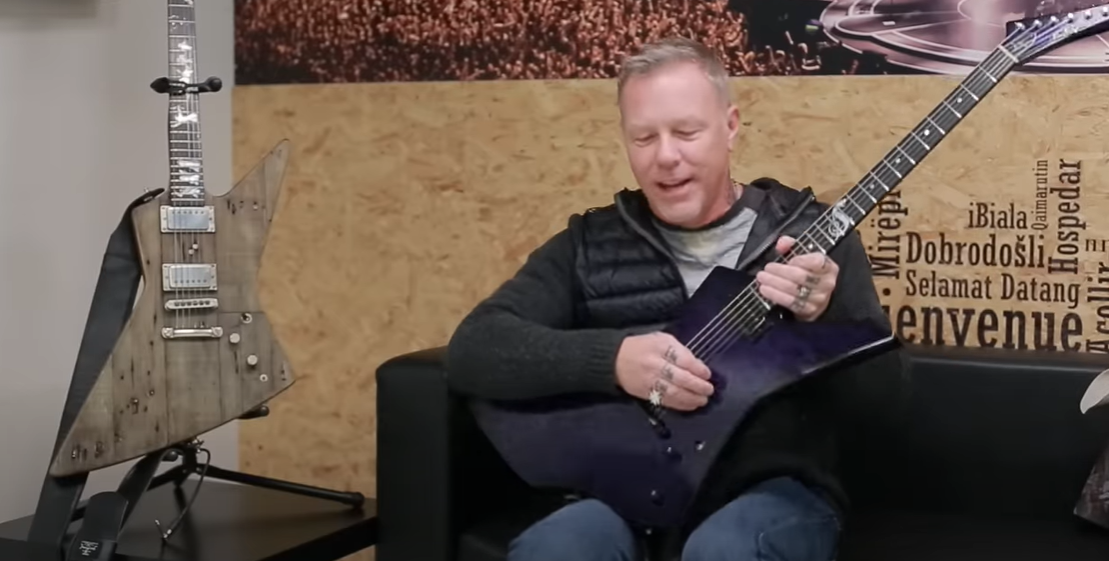
Mesa Boogie Mark IIC+ and Rectifier
While Marshall amps are often associated with Hetfield, he has also utilized Mesa/Boogie amps. In the 90s, he relied on a Mesa Boogie Mark IIC+ for albums like “Load” and “Reload.” This versatile amp allowed him to achieve a diverse range of sounds. In the early 2000s, Hetfield incorporated a Mesa Boogie Rectifier amp for the album “St. Anger.” The Rectifier is renowned for its heavy tone and tight low-end response. Hetfield has also ventured into other Mesa/Boogie offerings, including the Dual Rectifier and the Mark IV. Recently, he added the Mesa/Boogie JP-2C to his rig. Hetfield’s use of Mesa/Boogie amps exemplifies his commitment to crafting the perfect guitar tone and his willingness to explore different gear options.
Diezel VH4
In recent years, Hetfield has also been seen using the Diezel VH4 amp. This high-end, German-made amplifier is known for its pristine clean tones and massive gain capabilities. It provides a unique blend of modern and vintage voicings, making it a versatile choice for guitarists in various genres.
Hetfield used this amp on Metallica’s album “Hardwired… to Self-Destruct” and continues to use it live. The Diezel VH4 has allowed him to further expand his tonal options and deliver even more dynamic performances on stage.
Roland JC-120 Jazz Chorus
On the other end of the spectrum, Hetfield has also been known to use the Roland JC-120 Jazz Chorus amp. This solid-state amp is best known for its clean, warm tone and signature chorus effect. While it may seem like an unlikely choice for a metal guitarist, Hetfield has used this amp on songs such as “Nothing Else Matters” and “The Unforgiven” to achieve a softer, more atmospheric sound. By incorporating this amp into his setup, Hetfield has shown his versatility as a guitarist and his willingness to explore different sounds and textures in Metallica’s music.
Wizard Modern Classic
Another lesser-known amp in Hetfield’s arsenal is the Wizard Modern Classic. This boutique amp, handcrafted by Mark Hebert, was used on Metallica’s album “Load” and continues to make occasional appearances in Hetfield’s live rig. The Wizard Modern Classic offers a unique blend of vintage and modern tones, with a focus on high-gain distortion. It has become a favorite among guitarists seeking a high-quality, customizable amp for their rig.
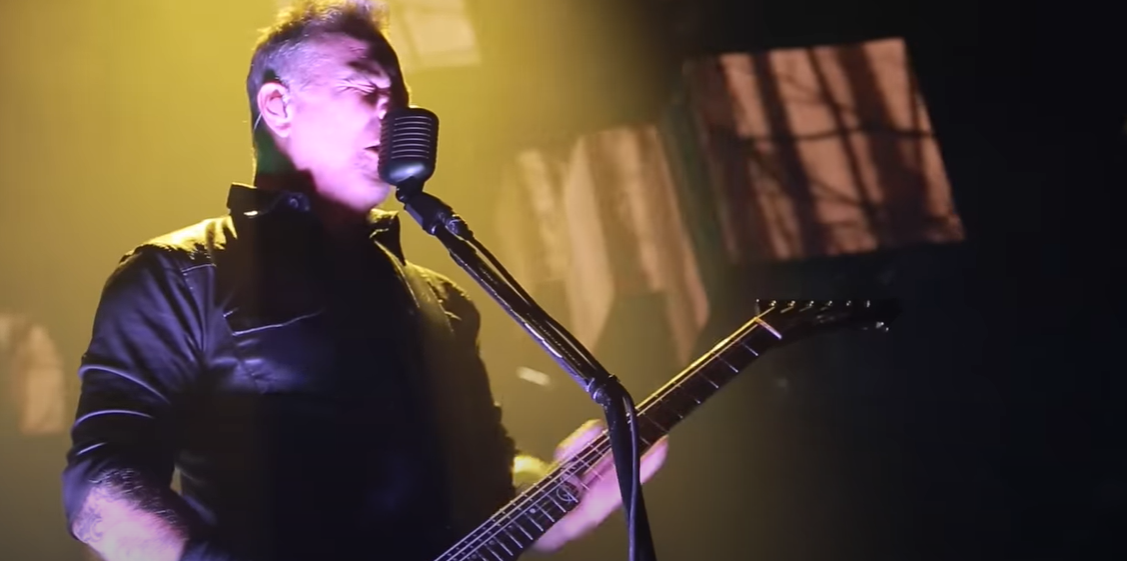
Pedals Used by James Hetfield
ProCo Rat
The ProCo Rat, a legendary distortion pedal, played a pivotal role in shaping the iconic sound of James Hetfield during the creation of Metallica’s “Kill ‘Em All” and “Ride the Lightning”. With its distinctive tone, the Rat enabled Hetfield to achieve the perfect blend of heaviness and aggression that defined the band’s early sound. Interestingly, Hetfield’s quest for sonic perfection led him to utilize two Rat pedals in parallel during the recording process, creating a massive and crushing wall of distortion. Not limited to its use as a distortion pedal, Hetfield also cleverly employed the ProCo Rat as a boost during his blistering solos, providing him with enhanced sustain and volume, ultimately elevating his guitar playing to new heights.
Electro-Harmonix Big Muff
The Electro-Harmonix Big Muff is another distortion pedal that was used by James Hetfield. He used this pedal extensively on the “Master of Puppets” and “…And Justice for All” albums, as well as live performances during that era. The Big Muff’s thick and heavy tone provided Hetfield with the perfect foundation for his rhythm guitar playing, while also adding a touch of grit to his lead work. Additionally, the pedal’s versatile controls allowed Hetfield to fine-tune his sound according to different song requirements, making it an essential part of his rig.
Ibanez TS9 Tube Screamer
As Metallica’s sound evolved and became more refined, James Hetfield turned to the Ibanez TS9 Tube Screamer for his overdrive needs. This popular pedal, known for its warm and natural overdrive tone, added a new dimension to Hetfield’s guitar playing on albums like “Metallica” (also known as the Black Album) and “Load”. The Tube Screamer’s ability to enhance the mid-range frequencies of the guitar made Hetfield’s already powerful riffs even more pronounced, solidifying his status as a riff master.
Klon Centaur
The Klon Centaur is another overdrive pedal that has been used by James Hetfield. This boutique pedal, known for its transparent and dynamic sound, was a key component of Hetfield’s rig during the “St. Anger” era. The pedal’s ability to add clarity and definition to his guitar tone proved essential in cutting through the chaotic mix on the album. Hetfield’s use of the Klon Centaur further demonstrates his commitment to constantly evolving and refining his sound, making him one of the most innovative guitarists in the metal genre.
Line 6 DL4 Delay Modeler
While distortion and overdrive pedals may take center stage in James Hetfield’s rig, the Line 6 DL4 Delay Modeler played a crucial supporting role. This versatile pedal allowed Hetfield to experiment with different delay effects, adding depth and texture to his guitar playing on songs like “One” and “The Unforgiven”. The DL4 also served as a looper, enabling Hetfield to create layered guitar parts and add extra dimension to Metallica’s live performances.
MXR M107 Phase 100
Last but not least, the MXR M107 Phase 100 is a modulation pedal that has been used by James Hetfield. This pedal, known for its distinctive swirling sound, was used on Metallica’s “…And Justice for All” album, particularly on the song “Blackened”. The Phase 100 added an other-worldly quality to Hetfield’s guitar tone, making it stand out even more in the mix. Its use on this album showcases Hetfield’s willingness to experiment and push boundaries with his sound, solidifying his place as a true pioneer in metal music.
FAQ
What guitar does Metallica guitarist use?
James Hetfield, the lead guitarist of Metallica, is known for using various guitars throughout his career. However, his most iconic and preferred guitar is a black ESP Explorer with EMG pickups. He has been playing this guitar since the early days of Metallica and it can be seen in many of their music videos and live performances.
What effects pedals does Metallica use?
Metallica is known for their heavy and distorted sound, which is achieved through the use of various effects pedals. Some of the commonly used effects pedals by Metallica include the Boss MT-2 Metal Zone, Dunlop Cry Baby Wah pedal, Electro-Harmonix Holy Grail Reverb pedal, and MXR Carbon Copy Analog Delay pedal.
What tuning does Metallica use?
Metallica is known for its heavy and aggressive sound, which is achieved through the use of alternate guitar tunings. The most commonly used tuning by Metallica is E flat standard, where all strings are tuned down by one half-step. They also frequently use drop D tuning, where the low E string is tuned down to D.
What guitar did James Hetfield use on Unforgiven?
On the recording of “The Unforgiven,” James Hetfield used his iconic black ESP Explorer with EMG pickups. However, for live performances of the song, he has been known to use a Gibson Les Paul Goldtop with P-90 pickups. He also experimented with different guitars during the recording process, including a Fender Stratocaster and a Gibson ES-335.
What is the meaning behind Metallica’s logo?
Metallica’s iconic logo, also known as the “Megaforce M,” was designed by James Hetfield and drummer Lars Ulrich. The inspiration behind the design came from an old horror movie called “The Haunting”, which featured a similar font on its poster. The logo has become synonymous with Metallica’s brand and can be seen on all of their albums and merchandise. Many fans have speculated about hidden meanings behind the logo, but according to Hetfield, it was simply a cool design that they liked. So, there is no deeper meaning behind it.
What guitar solos does Metallica use?
Metallica is known for its complex and melodic guitar solos, which are often performed by lead guitarist Kirk Hammett. Some of the most famous guitar solos used by Metallica include “Master of Puppets,” “Nothing Else Matters,” and “Fade to Black.” Many of these solos feature intricate guitar techniques such as tapping, sweeping, and fast alternate picking. Additionally, the band also uses harmonized guitar solos, where both lead and rhythm guitars play different melodies simultaneously. This creates a unique and powerful sound that is signature to Metallica’s music.
Metallica has had a huge impact on the world of heavy metal and has inspired countless musicians with their iconic sound. Their use of various guitars, effects pedals, tunings, and techniques have all contributed to their unique style and success. As they continue to tour and release new music, fans can expect even more innovation and creativity from this legendary band.
What ESP does James Hetfield play?
James Hetfield is known for playing a variety of ESP guitars. Some of the most notable models he has played include the ESP Explorer, ESP Vulture, and the ESP Snakebyte. He also has signature ESP models such as the LTD JH-600 and the LTD Iron Cross. Aside from these main models, he has also been seen playing custom-made ESP guitars with unique designs and specifications. So, it is safe to say that James Hetfield’s preferred guitar brand is ESP.
Useful Video: Metallica: Guitar Talk with James
Conclusion Paragraph
So, the guitars that James Hetfield plays are not just a piece of equipment that he uses on stage, but rather an extension of himself and his art. The iconic instruments have become a symbol of his talent and passion for music. Hetfield’s guitars also serve as a reminder that behind every great musician is a trusted instrument that helps them create their unique sound. Aspiring musicians can learn from Hetfield’s example and understand the importance of finding a guitar that not only sounds great but also feels like an extension of themselves. In conclusion, James Hetfield’s guitars are more than just tools for creating music; they are an integral part of his identity as a musician and an inspiration to others in the industry.
References:
- https://www.allmusic.com/artist/james-hetfield-mn0000146825/biography
- https://www.guitarlobby.com/james-hetfield-guitars-and-gear/





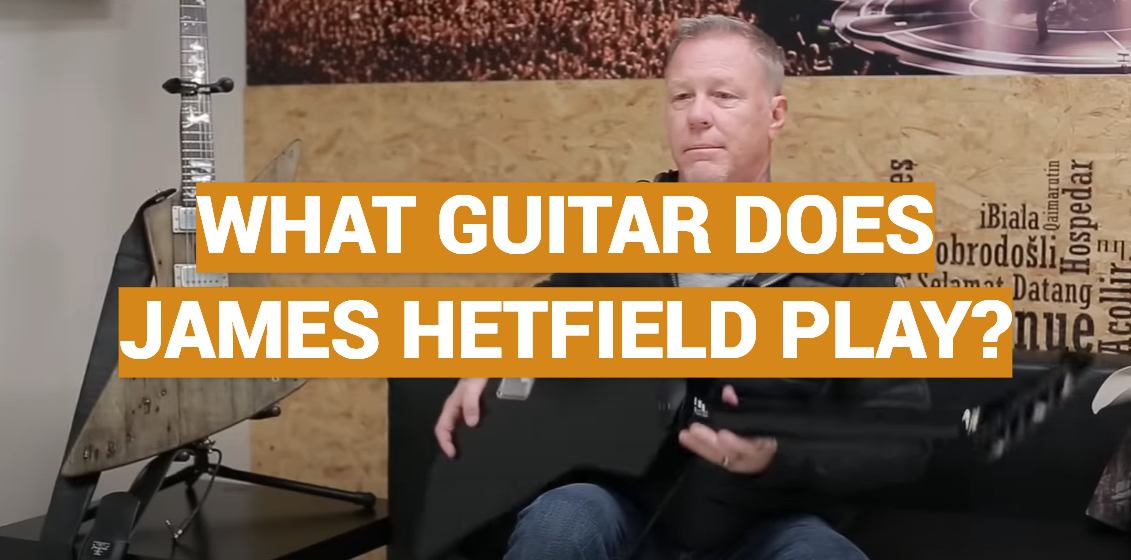




Leave a Reply